Reptile & Amphibian
News Blog
Keep up with news and features of interest to the reptile and amphibian community on the kingsnake.com blog. We cover breaking stories from the mainstream and scientific media, user-submitted photos and videos, and feature articles and photos by Jeff Barringer, Richard Bartlett, and other herpetologists and herpetoculturists.
Thursday, March 31 2016
What stunning colors on this male Sceloporus orcutti in our Herp Photo of the day, uploaded by kingsnake.com user eve. Be sure to tell them you liked it here!

Upload your own reptile and amphibian photos at gallery.kingsnake.com, and you could see them featured here!
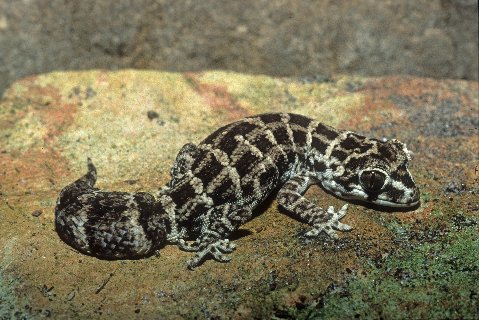
Small, stock, and with a distinctive tail and scalation, meet the carrot-tailed viper gecko.
Once quite commonly seen in the pet trade, for twofold reasons the little carrot-tailed viper gecko, Hemidactylus imbricatus (formerly Teratolepis fasciatus) is now harder to acquire. Firstly, there are almost no shipments coming to the USA from the Pakistan homeland of this gecko and secondly, for reasons not yet understood some breeders have found the hatchlings delicate. Hatchlings are said to often succumb within the first few weeks of their life.
This gecko of the rocky deserts attains an adult length of about 3 inches and is of stocky build. Despite its small size, once past the rather delicate hatchling stage, this is a hardy gecko that can live for many years in captivity on a diet of vitamin-calcium dusted baby crickets and tiny roaches.
The polygonal body scales are relatively small and only weakly imbricate. However the scales on the carrot-shaped tail are large and strongly imbricate.
My first examples came from a Pakistani friend in the early 60s. All arrived alive, bred readily, and within a year I had added several hatchlings to the growing colony.
Be these Hemidactylus or Teratolepis, they are an alert, primarily terrestrial, easily kept gecko, that is well worthy of consideration.
Additional reading: Bauer, Aaron M.; Varad B. Giri, Eli Greenbaum, Todd R. Jackman, Mahesh S. Dharne and Yogesh S. 2008. On the Systematics of the Gekkonid Genus Teratolepis Günther, 1869: Another One Bites the Dust. Hamadryad 32 (2): 90-104
Continue reading " Carrot-tailed Viper Gecko"
Wednesday, March 30 2016
What stunning colors on this male Sceloporus orcutti in our Herp Photo of the day, uploaded by kingsnake.com user arkherps . Be sure to tell them you liked it here!

Upload your own reptile and amphibian photos photos at gallery.kingsnake.com, and you could see them featured here!
Tuesday, March 29 2016
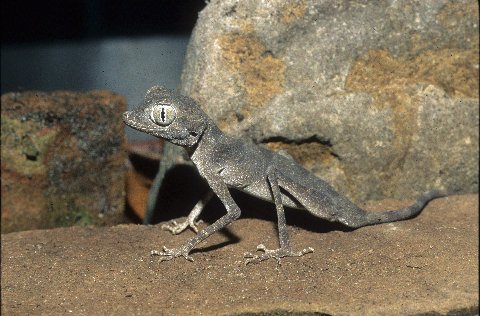
The name of spider gecko is derived from the long, spindly legs.The air mail letter from Jerry had just arrived from Karachi when our customs broker called and mentioned that we had an unexpected shipment from Pakistan at his facility. He could find neither packing list nor invoice within. Could we supply any info? I asked the broker to wait for a moment, opened the letter and found the needed documentation—a now forgotten number of leopard geckos, and a half dozen each of 3 other gecko species, 2 rat snakes, 2 whiskered vipers, and an Indian python were contained. I would fax it to him immediately. This was back in the 60s, at a time when U. S. Customs was easy to work with and there were virtually no state or federal regulatory laws. I expected no problems from this shipper’s oversight nor did we have any. The next morning the shipment was at our facility and I was eagerly unpacking it. I was familiar with most of the species from earlier shipments, but 2 species of geckos were new to me. One of these was the spider gecko, Agamura persica. What was this (remember there were few herp books and no computers/Google in those days)?
When after opening the bag I got my first look at this slender, big eyed, long legged, skinny tailed, creature I realized that I had never even imagined such a creature existed. I noticed too that they were devoid of toepads, and that when adult they are easily sexed, the males having pronounced hemipenial bulges as 5 of my 6 did. I also was quick to learn that the adult males were incompatible. The 6th individual, then a not sexable subadult, was a male.
Querying the shipper, I learned that this semidesert gecko was a saxicolous species, a terrarium type that was/is easily duplicated. In such terraria I found these geckos undemanding and very hardy.
And for this experience I say many thanks, Jerry.
Continue reading " Spider Gecko"
It's Two for Tuesday with this pair of Cresties in our Herp Photo of the day, uploaded by kingsnake.com user MOC_Reptiles . Be sure to tell them you liked it here!

Upload your own reptile and amphibian photos photos at gallery.kingsnake.com, and you could see them featured here!
Monday, March 28 2016
LOVE this Cribo in our Herp Photo of the day, uploaded by kingsnake.com user steve fuller ! We are so jealous! Be sure to tell them you liked it here!

Upload your own reptile and amphibian photos photos at gallery.kingsnake.com, and you could see them featured here!
Friday, March 25 2016
What a gorgeous pair of ( V.r.raddei) Radde's Rock Viper in our Herp Photo of the day, uploaded by kingsnake.com user tjern d! On Rattlesnake Friday, we celebrate ALL things venomous! Be sure to tell them you liked it here!

Upload your own reptile and amphibian photos photos at gallery.kingsnake.com, and you could see them featured here!
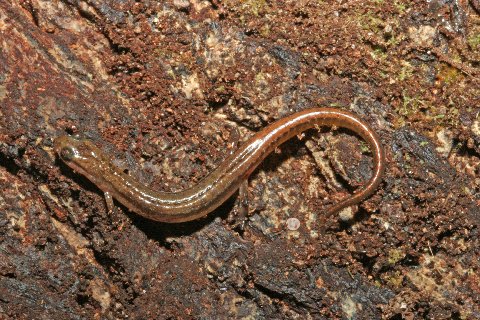
The dwarf salamander ranges from Texas to North Carolina and southern Florida.
It wasn’t crossing the road. It was lying quietly parallel with the yellow line and it was only 1 ¼ “ in length with a diameter hardly greater than a broom straw. It was a newly metamorphosed dwarf salamander, Eurycea quadridigitata. It was probably the smallest salamander that Jake or I had ever road hunted, and yes, I still wonder how either of us, never mind both of us, ever saw this creature that looked upon closer inspection like nothing more than a fine crack in the pavement?
Having an average adult length of 2 ¾ to 3 ¼ inches (and a record length just a hair over 3 ½ inches), at its largest the dwarf salamander is aptly named. As currently described this is probably a species complex. It is a salamander of southeastern swamplands and is small enough to hide beneath even tiny pieces of vegetative debris.
In keeping with its swampland habitat, this is a dark colored salamander. The dorsum is lighter than the sides, often bears a vague herringbone pattern and is divided by a narrow, dark, vertebral stripe that may be continuous or broken, and usually shades to a yellowish or sometimes orange color with no stripe on the tail. A dark dorsolateral stripe is present on each side. The sides and venter are grayish. There are only 4 toes on each foot.
I assure you that it was for the possibility of seeing other herp species that we had travelled to Florida’s Panhandle, but the finding of this little dwarf among dwarves was certainly noteworthy.
Continue reading "The Tiniest Salamander"
Thursday, March 24 2016
This African spur thigh tortoise in our Herp Photo of the day, uploaded by kingsnake.com user dinahmoe is just munching away without a care in the world. We are so jealous! Be sure to tell them you liked it here!

Upload your own reptile and amphibian photos photos at gallery.kingsnake.com, and you could see them featured here!
Wednesday, March 23 2016
What a sassy girl! Check out the attitude on this Kimberly rock monitor in our Herp Photo of the day, uploaded by kingsnake.com user bob. Be sure to tell them you liked it here!

Upload your own reptile and amphibian photos photos at gallery.kingsnake.com, and you could see them featured here!
Tuesday, March 22 2016
Love this in situ shot of an alterna climbing the rock cuts in our Herp Photo of the day, uploaded by kingsnake.com user StuTennyson . Be sure to tell them you liked it here!

Upload your own reptile and amphibian photos photos at gallery.kingsnake.com, and you could see them featured here!
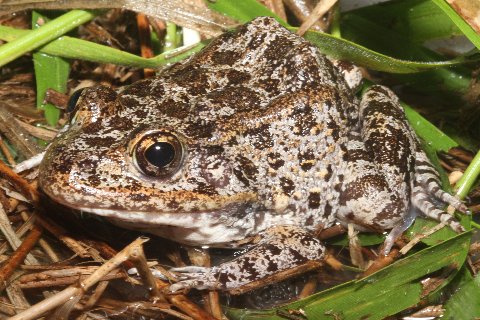
An adult male Florida gopher frog.
Living in a region where a goodly number of anurans exist has its herpetological ups and downs. The ups are that on almost any rainy night throughout the year we can see or hear some species of frog, toad, or treefrog. The downs are that to find some species we have to brave the chilly nights and cooler waters (remember, we are Floridian wimps!) of seasons other than midsummer. But, when we do tailor our searches a bit and search out cool weather species, we may find the gopher frog, Rana capito aesopus, a localized and secretive taxon that awaits heavy rains and flooding conditions to begin its breeding sequence.
And so it was on this night. It had rained, poured, rained, then misted all day and Jake decided this was the night when gopher frogs would be active. The problem was, he hadn’t cleared this with the gopher frogs. But Jake swore that that if I would just get him to where the frogs were he WOULD NOT come back to the car without a picture. So we headed westward to visit a known gopher frog locale.
When we arrived it was almost dark, it WAS windy, and it was cool. We could hear no gophers from the road so we, in shorts and flipflops, clawed and shoved our way through 100 feet of brambles and thorny shrubs to pond edge. By this time it was cold, windy and moonlit. But guess what? Gophers WERE singing. We got to the water and I said something to the effect of "they're here, they're singing, go get 'em Jake." His response was "ummmmmm--I forgot my camera."
By now the frogs were calling loudly so I suggested that Jake go and at least find one so he could add it to his life list. He went. I stood and shivered. Jake got 1/4 way across the pond and the frogs stopped singing. Jake stood. One frog called. Jake, sounding like a dyspeptic porcupine, produced an answering snore. Lo, the frog called again. Jake stalked s-l-o-w-l-y towards it. It was now a contest of whether the pond would evaporate or the frog would die from old age before he got to the calling site.
OK, so you've got the idea by now. The trip was a washout. Frogs 10. Jake and me, zero. But we had fun, and later that year, on a warmer and even rainier night, we were more successful. Jake got his photos.
Continue reading "Gophers—Frogs That Is"
Monday, March 21 2016
We hope that this amazing field shot of a Wood Frog kicks off your Monday right in our Herp Photo of the day, uploaded by kingsnake.com user casichelydia . Be sure to tell them you liked it here!

Upload your own reptile and amphibian photos photos at gallery.kingsnake.com, and you could see them featured here!
Friday, March 18 2016
In for spring to hit this weekend, a beautiful photo from an outdoor shoot of an albino Western Diamondback in our Herp Photo of the day, uploaded by kingsnake.com user krantz d! Be sure to tell them you liked it here!

Upload your own reptile and amphibian photos photos at gallery.kingsnake.com, and you could see them featured here!
Thursday, March 17 2016
Now for something a little bit different. This pair of Gran Canaria giant lizard (Gallotia stehlini) are just trying to find a little privacy in our Herp Photo of the day, uploaded by kingsnake.com user John-C . Be sure to tell them you liked it here!

Upload your own reptile and amphibian photos photos at gallery.kingsnake.com, and you could see them featured here!
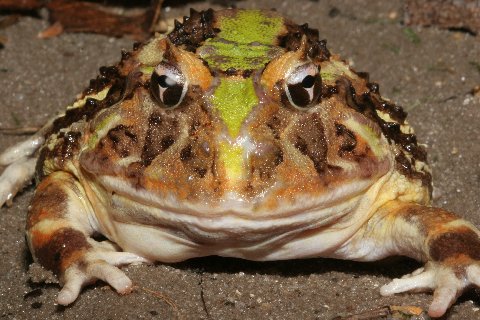
All brown, brown and green, or green are all common color variation of the Caatinga horned frog.
When the death of a pet occurs it is disturbing. When the death of a healthy pet occurs it is infinitely more disturbing. And this latter occurred a while ago when my male Caatinga horned frog, Ceratophrys joazierensis, was killed by my female during a breeding attempt.
There is always a chance of such things happening when cannibalistic frog meets cannibalistic frog, but this surprised for vocalizations had led to amplexus and I was reasonably sure that all was well in the rain chamber. But this time I was wrong. For some reason amplexus was discontinued, and the female turned, grasped the male by one hind leg and faster than I could intercede swallowed the male to midbody. By then I had them in hand, pried her jaws open, released the male (who at that time seemed none the worse for that harrowing experience) and separated the pair.
But despite there being no outward sign of the aggression something detrimental had happened to the male because from that day, until his death 2 weeks later, he simply sat in one spot (not unusual for a horned frog) and he never again ate (very unusual for a horned frog).
Since that time I have been looking for a replacement male. I know this taxon has been bred in captivity so there are some out there somewhere. But until now I have neither seen nor heard of any being available. But I’ll keep looking…
Continue reading "A Horned Frog Predicament"
Wednesday, March 16 2016
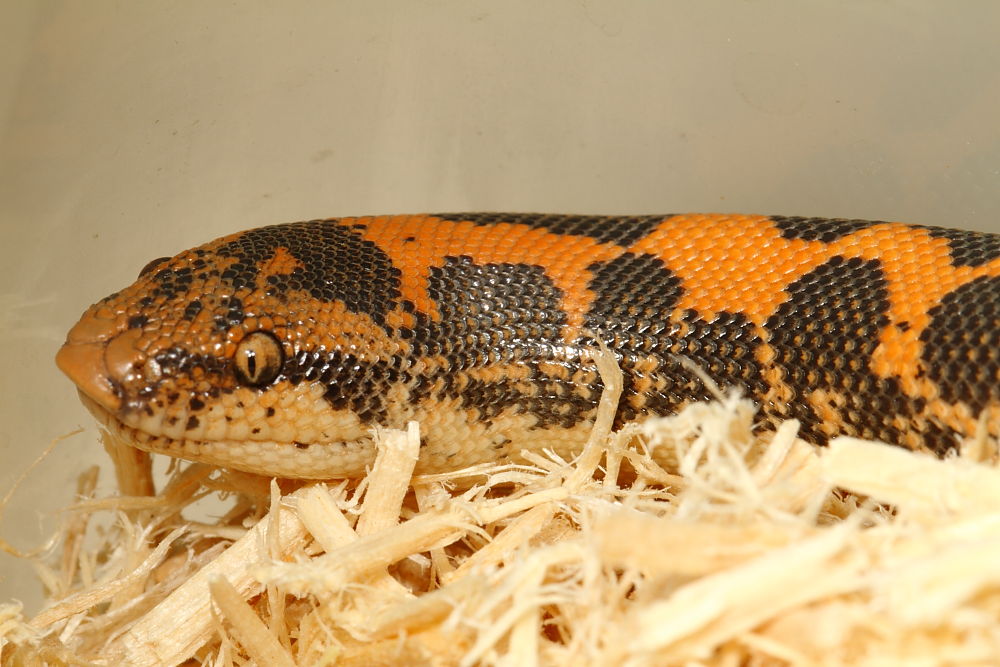
I will never forget my first Kenya Sand Boa experience. I was around 14 years old when I saw my first babies at the local pet store and I had to buy a pair. It took me over a month to pay for them and I took feeding them and making them breeder sized very seriously. By the time I hit 17 I was working at the shop where I bought them and when my female gave birth I called my boss at around midnight to tell him. I was excited, and he was exhausted!(LOL) But when I got to work the next day he had a big banner up across the isles of the store congratulating me. It was the first time I ever bred a Boa. As I inched towards 40 I had bred many species of snakes and learned that they all took up space, so that got me thinking about Sand Boas again. There are no fortunes to be made here, but the fact is that I find the process to be fun. Not sure if this is manopause or not, but here I am breeding these little worms again. Pictured is my holdback female from 2015. Call it what you will, I am guilty as charged!
What an amazing field find! This baby 3 toed box turtle is emerging from it's nest in our Herp Photo of the day, uploaded by kingsnake.com user relic37! Be sure to tell them you liked it here!

Upload your own reptile and amphibian photos photos at gallery.kingsnake.com, and you could see them featured here!
Tuesday, March 15 2016
In our opinion, Water Snakes, like the one in our Herp Photo of the day, uploaded by kingsnake.com user Lachesis1 are among the most under-rated and misunderstood of our non-venomous snakes. We, however, love them! Be sure to tell them you liked it here!

Upload your own reptile and amphibian photos photos at gallery.kingsnake.com, and you could see them featured here!
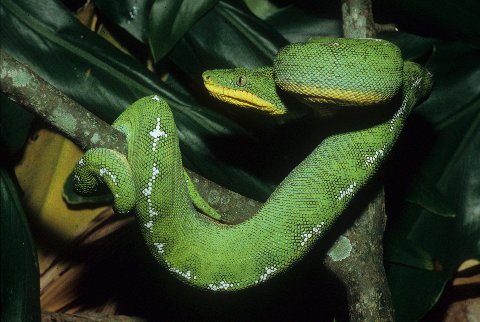
A beautiful adult Basin emerald.
It seems it always happens this way. For about 20 years, on innumerable trips to Amazonian Peru, I and those who have travelled with me, have searched long and hard for what is considered by many the gem of the Amazonian rainforests, the Basin emerald tree boa, Corallus batesii.
Stated as succinctly as possible, despite the thousands of search-hours spent, we failed. We found 150 other species of herps, but when it came to the emerald, pure and simple, we failed. Years passed and this year (2015) I elected to retire. A few weeks after having done so, friend, Kenny (a biologist and geneticist) decided that he’d like to research the wildlife of what had become our major preserve, Santa Cruz Forest Preserve on the Rio Mazan in Amazonian Peru. He and his family moved to the preserve for a year long stint.
Four months into it Kenny texted me “You retired too soon” and attached a pic of the coveted emerald tree boa. It seems that Kenny, accompanied by his wife, Maria, and a village youngster, Cain, by name, were taking an evening stroll along the main trail when, only a few meters from the compound, Cain noticed the snake. It was hanging head downward, nose only a few inches from the leaf litter of the forest floor, in a small tree only a foot or so from trail edge. Kenny’s correct. I retired a few months too soon.
Continue reading "Emerald Tree Boa—Finally!"
Monday, March 14 2016
Our favorite type of blue Monday! Check out these stunning dart frogs in our Herp Photo of the day, uploaded by kingsnake.com user frogological! Be sure to tell them you liked it here!

Upload your own reptile and amphibian photos photos at gallery.kingsnake.com, and you could see them featured here!
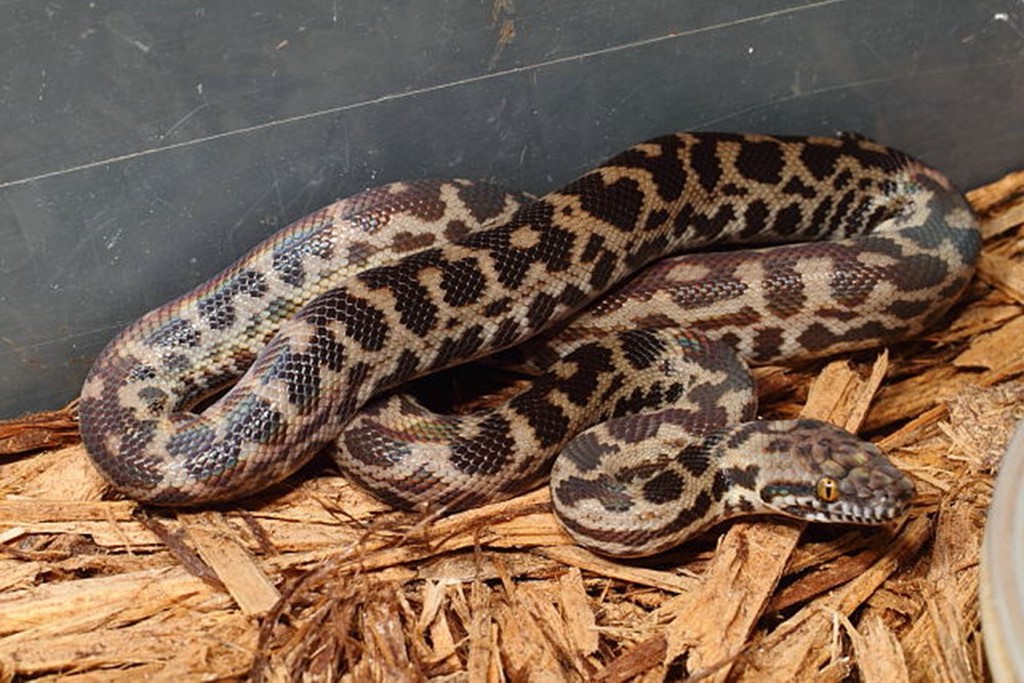
Last week a friend bought a sexed pair of Spotted Pythons from me. It took him 4 weeks to save up the funds, and during that time he asked me all the right questions and got everything ready. Within two hours after arriving home and getting the snake put away he discovered that one had escaped…the female of course!
I hate the fact that people have to go through things like this, but most of the time it takes a loss and a bad mistake in order to learn. When it comes to keeping snakes it is a fact that there are forces working against us all at every turn. Even when it is legal and you go out of your way to do everything right, all it takes in one tiny detail to ruin everything and foul up all the fun. In my experience I have found that my work is never done and that it is best to always be on the lookout for how I can make things better. In this case the snakes were put in a baby rack made for snakes, but they still got out even though the snake was over 7 months old and no longer a baby. When I put baby snakes in a rack I fold up newspaper and put it under the box so that it is raised up and made even tighter with the top of the rack. Of course, that restricts air flow so I have to drill more holes to make sure my snake can breathe! It seems that every adjustment requires an additional adjustment! The work never ends, and if you think your work is done I bet something will go wrong while you are sitting back relaxing thinking that all is well! Be careful out there fellow snake keeper! It is all in the details!!
Friday, March 11 2016
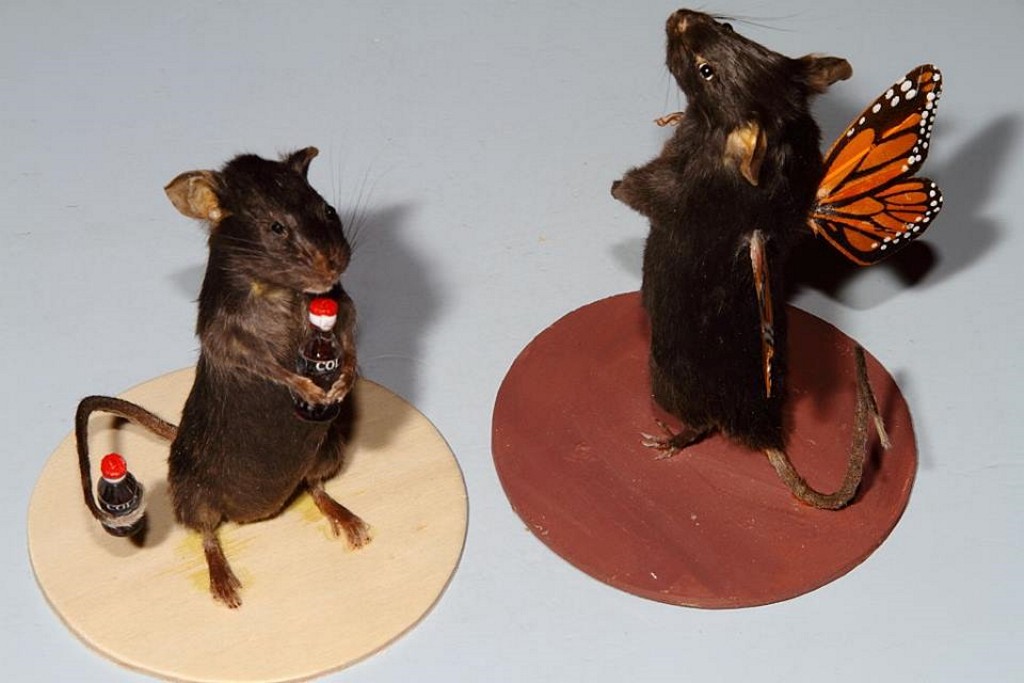
I recently took my daughters to their first reptile show. Once inside they were drawn to a booth with dozens of mounted rats and mice along with rat bone necklaces and mouse skull jewelry. I allowed each of my girls to select a specimen, and as I discussed the terms of the price with the two mouse women a long line formed behind me. I watched as everyone in the line attempted successfully to sell their dead rodents. The herp show had gone green and was recycling dead feeders! I learned that there was a demand for dead snakes too! My favorite item was a jumbo rat mounted on remote controlled wheels. I could sure have some fun with that!
Thursday, March 10 2016
In our celebration of all things venomous on Friday, this little rough-scaled bush viper ( Atheris hispida) in our Herp Photo of the day, uploaded by kingsnake.com user eekster26 is looking forward to the weekend! Be sure to tell them you liked it here!

Upload your own reptile and amphibian photos photos at gallery.kingsnake.com, and you could see them featured here!
What a stunning Leopard Gecko in our Herp Photo of the day, uploaded by kingsnake.com user Eve! Be sure to tell them you liked it here!

Upload your own reptile and amphibian photos photos at gallery.kingsnake.com, and you could see them featured here!

Still with well defined facial markings, this black-breasted leaf turtle is about a quarter grown.
Have you ever wanted to kick yourself in the butt for getting rid of a particular herp or for passing by the opportunity to purchase a given species. On several occasions I have done both and regretted it for a long time after.
For example, I regret not acquiring a photo of the Javan tubercled or dragon snakes when they were being offered. It is true that they have proven difficult (read that impossible) to keep as captives but there has to be a key to that problem somewhere.
Of the herps that I am most upset at allowing myself to be talked out of was and still is my 2 pairs of black-breasted leaf turtles, Geomyda spengleri spengleri.
There are several Asiatic turtle species of which I am fond, several members of the genus Cuora among them, but IMO none compare with this little leaf turtle.
This is not because of color. This leaf turtle is a variable but often dingey brown above with very pronounced posterior carapacial serrations. The yellow(ish) rimmed plastron is mostly black. The skin is also brown with the only noticeable highlight being the stark white irides of the protuberant eyes.
So, if it’s not color what is it about these four inch long Asian turtles that is so enchanting? One word—personality. Once acclimated this turtle, naturally alert, quickly becomes tame-- actually outgoing—and seems contemplative. It reminds me in more ways than one of our little bog turtle but outdoes the boggy in each aspect…
Time to close. I’ve almost talked myself into another purchase.
Continue reading "Black-breasted Leaf Turtle"
Wednesday, March 9 2016
Is this Irian Jaya Jag in our Herp Photo of the day, uploaded by kingsnake.com user StonedReptiles bright enough for you? Be sure to tell them you liked it here!

Upload your own reptile and amphibian photos photos at gallery.kingsnake.com, and you could see them featured here!
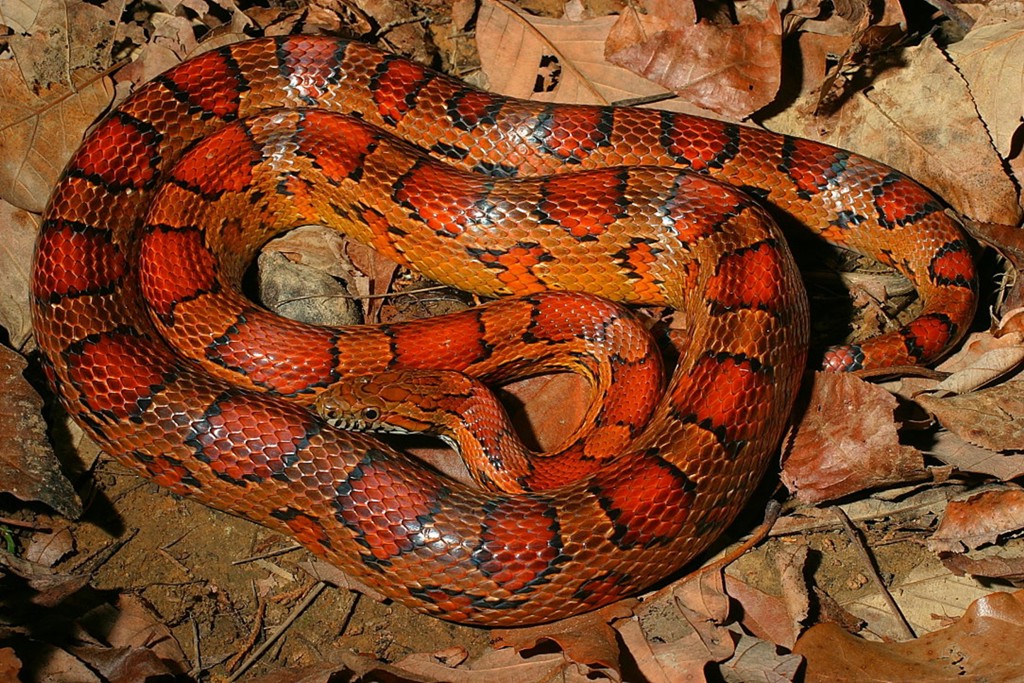
In high school I got my hands on Barbours book about Snakes in Kentucky and will never forget gazing at the picture of the Corn Snake and learning that a small and isolated population of these snakes occurred in Kentucky. Little did I know that the names of the other students who checked out that book would be my future bosses and co-workers at The Louisville Zoo, or that my friend Phil Peak and I would one day focus in on this serpent and spend countless hours in the counties that seemed so far away and foreign to me at the time.
It took some effort to locate my first specimen by the time that I was in my 20’s, but once I began to figure them out I was able to locate well over 100 of them in a very confined area. Phil and I were able to establish a small group of these snakes in captivity and we donated babies to educational facilities across Kentucky. We also gave them to people in our local Herp Society so that they could be used in presentations, and also so that our local people would not feel the need to go down and remove additional specimens from the wild. Phil and I had a lot of questions about this isolated population of snakes so we began to record as much information about each specimen as we could. In addition to blotch and scale row counts we were also able to determine when they emerged, when they bred, when they laid eggs, when the babies hatched, and when the adults went back underground to spend the winter. After compiling all of our data we began the process of publishing our work in a scientific format. This process was long and complicated for us, and we were fortunate to meet Danna Baxley who came onboard with our efforts as a co-author and helped us organize the work in a way that was presentable and acceptable to the newly formed Journal of North American Herpetology where it was published in 2015. To anyone interested in the scientific paper, here is a link to the PDF file that can be found on the Center For North American Herpetology website: http://www.cnah.org/pdf/88314.pdf
It is difficult to fully describe everything that was involved in this whole process in the short format here, so I will close it out by saying that the journey from my high school library all the way to being published in a scientific journal was a long and interesting experience that has left me grateful to the local people of rural Kentucky and to my friends Phil Peak and Danna Baxley whose knowledge and patience made possible what I could not have done on my own.
Tuesday, March 8 2016
Crocodilians come out of the egg sassy, like this Cuvier's dwarf caiman in our Herp Photo of the day, uploaded by kingsnake.com user sk8r009 give us a serious case of the "awws"! Be sure to tell them you liked it here!

Upload your own reptile and amphibian photos photos at gallery.kingsnake.com, and you could see them featured here!
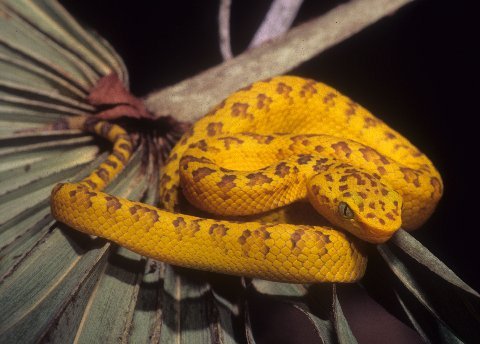
Many McGregor's pit vipers are strongly patterned.
This is another of today’s choose your name species. This beautiful and variable pit viper from the Philippine islands of Batan and Sabtang (perhaps introduced to other locales) has gone from its 1913 described name of Trimeresurus mcgregori (named for the collector of the first specimen who just happened to receive and survive a bite) to Trimeresrus flavomaculatus mcgregori, then to Parias mcgregori, and now back to the starting name, T. mcgregori.
This is one of the more variably colored pit vipers, ranging from solid brown to a pure silvery white and having many shades of yellow and a few differing patterns between those 2 extremes. It is adult at about 3 feet in length. It is an oviparous species.
Protected in its Philippine homeland and the relatively few captives having proven problematic to breed, this beautiful pit viper is not a frequently seen species in collections. As would be expected, when on the rare occasions this taxon does become available, the prices asked are often out of range for all but the most dedicated of venomous keepers.
Continue reading "McGregor’s Pit Vipers"
|



